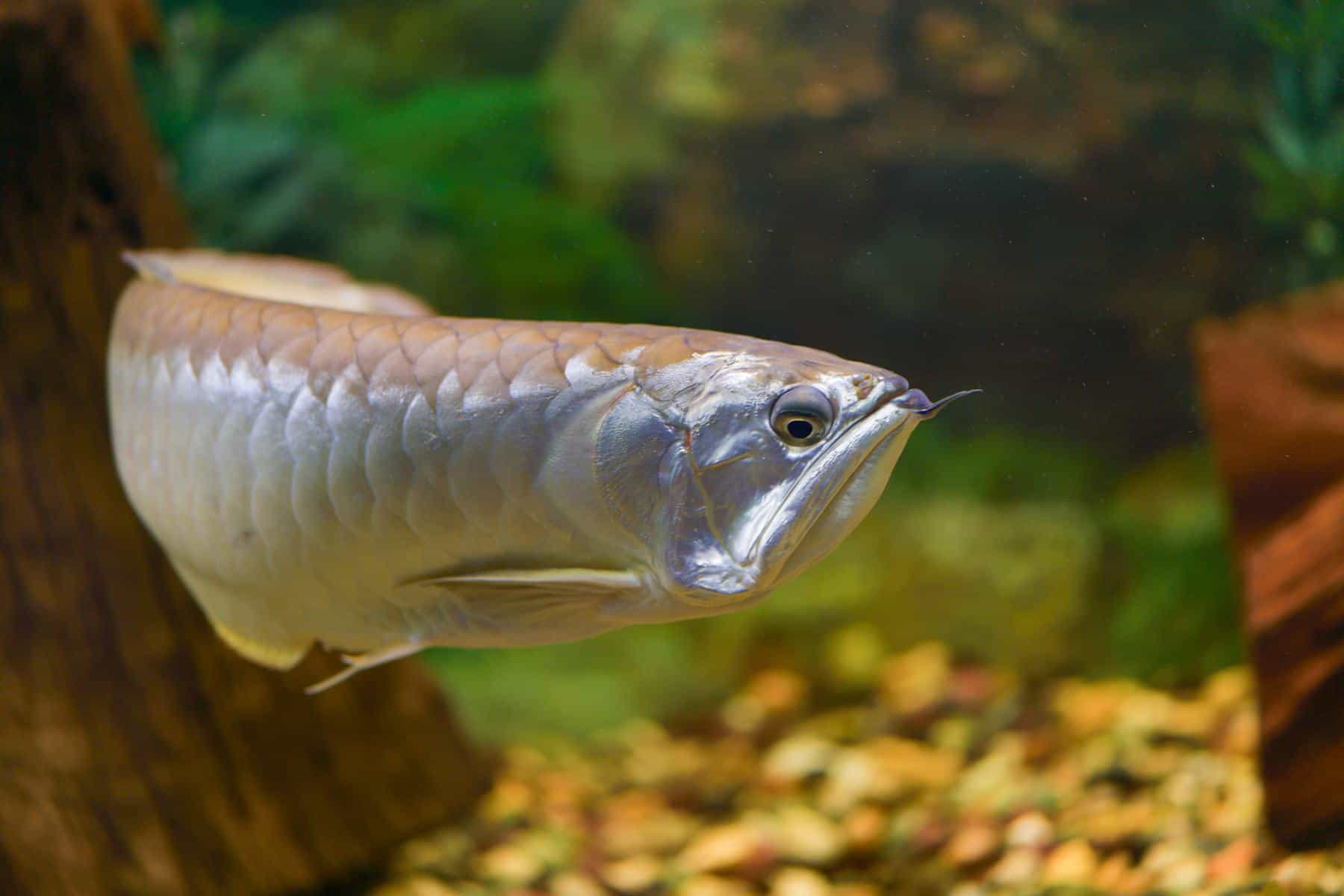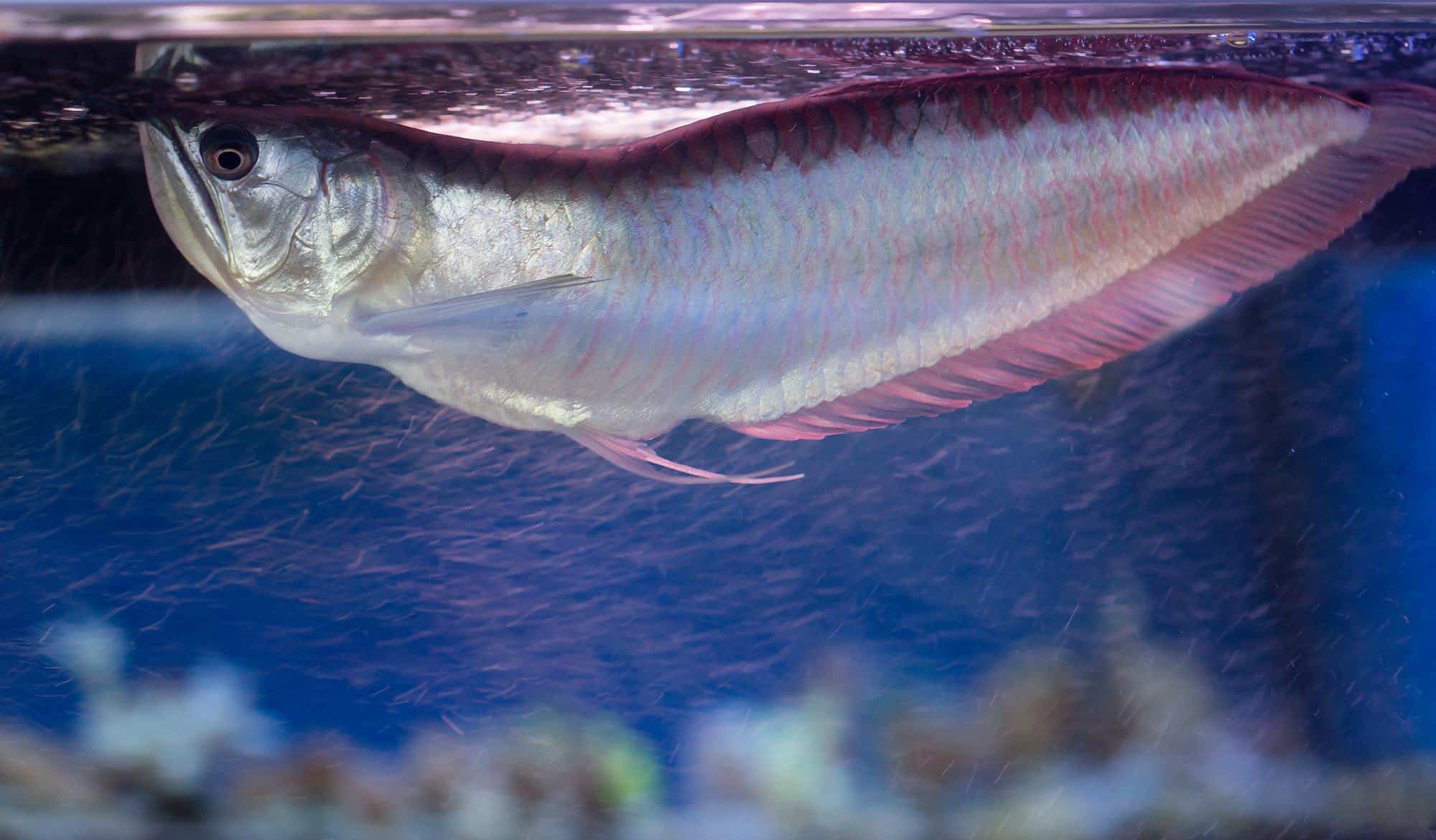Possibly one of the coolest freshwater fish to have in your aquarium, the silver arowana is a staple fish for large tank systems. These monster fish can easily surpass 3 feet (92 cm) in length, live up to 20 years, and have a giant mouth that can easily suck in smaller fish and invertebrates. Though silver arowanas are usually sold as juveniles, it is important to understand the true mature size, lifespan, and dietary needs of this species of fish.
Keep reading to find out everything you need to know about silver arowana care and possibly keeping one of these fish in your own freshwater aquarium!

Name
Osteoglossum bicirrhosum is commonly known as the silver arowana, which is sometimes spelled as arahuana; they have also been labeled as ‘monkey fish’ due to their ability to jump out of the water and catch prey as well as ‘dragon fish’ due to their large scales. These fish have had several other scientific descriptions since their discovery, including Osteoglossum vandelli and Ischnosoma bicirrhosum, and may still be referred to as such depending on the source.
Silver arowanas are members of the Osteoglossidae family, which is often defined as the freshwater fish species with a ‘boney tongue’; these kinds of fish have a bone structure on the bottom of their mouth that is equipped with teeth and used to crush food against the top of the cavity. They are also classified as true bony fish, which means that the rest of their skeleton is made from bone rather than cartilage.
Fossil records of Osteoglossidae species date back 150 million years.
Natural habitat
Silver arowanas can be found in many parts of northern South America, including regions of Brazil, Colombia, Peru, Ecuador, Guyana, and French Guiana. More specifically, they have been documented throughout the Essequibo, Oyapock, and Amazon river basins.
It is common to find silver arowanas at the top of slow-moving and standstill areas where they can hunt for prey in and out of the water. These ecosystems also usually have blackwater conditions, with tannin-stained water from fallen detritus and branches from the jungle canopy above. Silver arowanas are facultative air-breathers, which means that they can breathe atmospheric air if necessary in poor water conditions.
It is believed that silver arowanas migrate with the dry and wet seasons. During the dry season, they tend to stay in calmer areas, like those found in tributaries and lagoons. Once the rivers swell with rain, these fish take to the larger waterways where food is more prevalent.
A few silver arowana have been caught in nonindigenous waters across the United States, though it is not currently believed that these populations are self-sustaining. More than likely, these sightings are the result of aquarium releases due to high tank maintenance and care.
Silver arowanas are also prepared as a dish in some local areas around their river ecosystems. Due to their popularity in both the fishkeeping hobby and local dietary importance, wild populations of these fish are being monitored and harvesting regulations are being enforced.
Identification

The silver arowana is easy to identify, but can sometimes be a little tricky to differentiate from other similar arowana species. True silver arowanas have relatively large, silver scales that take on an almost-metallic shine; they are sometimes referred to as ‘dragon fish’ due to their mythical appearance similar to that seen on creatures in folklore.
Silver arowanas have a long and slender body; their dorsal and anal fins start around three-quarters of the way down from their head and extend all the way to their tapered caudal fin. They have a notably large, downward-facing mouth that easily sucks in food.
The silver arowana (Osteoglossum bicirrhosum) is sometimes confused with the black arowana (Osteoglossum ferreirai), especially in their adult life stages. Juvenile silver arowana will have a dark lateral line whereas juvenile black arowana will have darker features overall, most noticeable in the fins. Adult silver arowanas and black arowanas are a little more difficult to tell apart from each other; the main distinguishments are seen in the number of dorsal fin rays, anal fin rays, and vertebrae count.
In general, the best way to guarantee the species of the fish is by going to a reputable seller. However, you can also tell by body shape and behavior if you know what to look for. Silver arowanas tend to have a much fuller and lighter-colored body than black arowanas and seem to be a little more territorial in a tank setting than their darker counterparts.
How big do silver arowanas get?
These South American fish are often referred to as monster fish, but how big do they truly get?
The silver arowana can easily surpass 3 feet (36 cm) in length, though it is unclear how long they can actually get. One of the largest silver arowanas in captivity has already reached the 4 foot (48 cm) mark!
However, most fish are sold as juveniles and look completely manageable to care for when still small. The truth is that these fish can grow about 2 inches (5.1 cm) every month in the beginning stages of their life! There is no such thing as keeping a silver arowana in a temporary tank.
Along with their size, silver arowanas can also live for a considerably long time. It is believed that they can easily live for 10+ years in the fishkeeping hobby under ideal conditions. Unfortunately, not many hobbyists are able to accommodate the tank size and lifespan of these fish and they are donated to aquariums or released into nonindigenous waters.
Are silver arowana illegal to own?
As one of the most common monster species available in the freshwater aquarium trade, you might find yourself asking if it’s even legal to own such a fish!
For the most part, South American silver arowanas are legal to own throughout the world. However, it is important to check with local regulations regarding the species even if the seller insists that it is legal; some jurisdictions might require permits while others might have bans on specific arowana species entirely.
One of the most notable species of arowana to be banned from international trade is the Asian arowana (Scleropages formosus), also known as the Asian bonytonue or Asian dragon fish. The Asian arowana is listed as endangered due to declining populations as a result of habitat destruction.
How much does a silver arowana cost?
The price of a silver arowana depends on the size and quality of the fish. Online, juveniles are usually marked for sale at 50 USD while larger fish can go for upwards of 200 USD. Other color variations and/or quality of breed may fetch for more money.
While this might not seem like a lot for such an impressive fish, as we’ll discuss, the tank setup and maintenance for this species can become quite demanding and expensive. Also, keep in mind that any legal permits may result in additional costs.
Silver arowana tank requirements
Silver arowanas can grow to be over 36 inches (92 cm) long. This means that both the length and width of the tank need to be larger than this; the height also needs to allow the fish to naturally establish a territory in the upper water layers of the tank. This means that an aquarium of at least 250 gallons (946 L) is recommended to house juveniles and adults; in general, the best tank will have dimensions that allow the fish to comfortably turn around and exhibit natural predatory behaviors.
Otherwise, they don’t require too much to make them happy. Because they do best in larger tanks, adequate filtration and water movement is necessary for nutrient export and gas exchange. Their metallic colors reflect best against a dark substrate, though they can also be kept in a bare-bottom tank setup.
Floating plants and vegetation are appreciated as these fish spend most of their lives just beneath the surface of the water. Decorations should be minimal in order to provide your fish with as much swimming space as possible.
In order to accommodate the extreme size of these fish, some hobbyists have chosen to keep them in a pond setting instead of an aquarium; some have even converted aboveground swimming pools into a pond for their monster fish! Because silver arowanas naturally jump out of the water to catch prey in their South American ecosystems, a protective netting is recommended for both pond and tank setups to keep your fish from jumping out while also preventing injury.
Water parameters
Silver arowanas come from the tropical river ecosystem of South America and can be pretty hardy when it comes to water conditions. These fish will need a stable water temperature between 75-82° F (23.9-27.8° C) with a relatively neutral pH between 6.0-7.0.
Though they are usually seen in calm water conditions, they can withstand moderate water flow.
Silver arowana tank mates

Though large fish, silver arowana can actually be kept with an assortment of fish species. As we’ll see, adults do better with less-aggressive species and juveniles can actually be quite fragile in their early stages. Because of this, it is best to keep juvenile silver arowanas in a relatively calm tank until they grow to 5+ inches (12.7+ cm).
It is also important to remember that silver arowana stay at the surface of the water almost all of the time. When stocking your tank, it is best to go with middle and lower water column swimmers to avoid any aggressive interactions that might occur.
What fish can live with silver arowanas?
In general, predatory fish tanks are large with little diversity. This means that your silver arowana tank might look a little empty at first, with only a handful of fish. It is important to remember that most of the listed tank mates will also reach impressive sizes when fully grown and your tank will take some time to fully fill out!
Some of the best tank mates for silver arowanas are:
- Gars (Lepisosteiformes order). Gars are slender bony fish that date back to the late Jurassic period. They are usually easily identified by their elongated jaws. Tropical gar (Atractosteus tropicus), Florida gar (Lepisosteus platyrhincus), and Cuban gar (Atractosteus tristoechus) have proven to be successful tank mates with the silver arowana.
- Giant gourami (Osphronemus goramy). The giant gourami is usually one fish to avoid in fishkeeping but actually does well in silver arowana tanks. In captivity, giant gouramis grow to to be about 16 inches (40.6 cm) big at their mature size and need a 200 gallon (757 L) aquarium or more. However, their peacefulness and solitary lifestyle make them a good pairing for arowana.
- Freshwater stingrays. Stingraysshould only be kept by hobbyists who have experience keeping elasmobranchs as they require extra care and attention. Common arowana pairings are motoro stingrays (Potamotrygon motoro) and black diamond stingray (Potamotrygonidae family). Note: Stingrays are banned from many states and countries for commercial purposes.
- Dinosaur bichir (Polypterus senegalus). Another prehistoric fish, the dinosaur bichir can grow to be almost 2 feet (61 cm) long. They have specialized pectoral fins that they use to push themselves across the bottom of the aquarium so your silver arowana stays unbothered at the top.
- Clown knifefish (Chitala ornata). Knifefish are very distinct and don’t even look like a type of fish at first; they don’t have any scales or fins! However, clown knifefish can get to be around a foot or two (30.5-61.0 cm) long and need plenty of space to swim around.
- Clown loaches (Chromobotia macracanthus). It is common for clown loaches to receive improper care in the form of small tanks and small numbers. However, a silver arowana tank is actually just what they need to thrive and live a full life. While they might look small when you first bring them home from the aquarium store, these fish can grow to be over a foot (30.5 cm) long. They also need to be kept in schools, which require a very big tank!
Silver arowana behavior
Adult silver arowana are solitary fish; they like to stay in the upper water column, feeding on small fish, invertebrates, and other animals. They can become aggressive towards any fish that also prefers the top water column, so it’s best to avoid other surface swimmers entirely.
They may also become aggressive towards other similar-looking fish. Otherwise, they can be seen effortlessly gliding back and forth just under the surface of the water waiting for food.
Juvenile silver arowanas are actually susceptible to being bullied by other fish. It is usually recommended to first keep your juvenile arowana with more peaceful species or in another tank entirely to allow it to grow out.
In the wild, these fish are known to jump out of the water to eat large insects and sometimes even small mammals and birds. Because of this, it is best to keep a net over the aquarium or pond at all times.
Silver arowana diet
Feeding such a large fish can be difficult and expensive; these fish are known to be somewhat picky eaters in the early stages of their life in the aquarium setting. The silver arowana is primarily a carnivore, hunting other fish and insects of a considerable size. However, they have also been documented eating fallen fruits and nuts from the jungle canopy above in the wild.
As juveniles, silver arowanas can be fed smaller foods. However, they should be given a varied diet, including live and frozen foods. While small, worms (bloodworms, earthworms, Tubifex worms), krill, mosquito larvae, and fish flakes/pellets may all be offered.
As they grow, you can begin to offer live, frozen, and freeze-dried foods; freeze-dried foods lack a lot of the important nutrients to aid in growth and should be avoided until your fish is at least a year old. Worms (bloodworms, earthworms, and Tubifex worms) can continue to be fed, along with krill, fish flakes, and pellets. However, you may also start offering some larger prey like insects (crickets and mealworms), other invertebrates (mussels, clams, shrimp, prawn), pieces of fresh fish, or even live feeder fish.
Note: Only consider using feeder fish if you have a reliable supplier; feeder fish are known to carry disease and parasites and could potentially affect all the fish in your tank!
Breeding silver arowanas

Because these freshwater fish are so large and can become territorial towards each other in small spaces, breeding in captivity is usually not possible.
In the wild, these fish spawn at the beginning of the rainy season. The adult fish form pairs and the female lays the eggs. The male then takes the eggs into his mouth where they later hatch. It takes about two months for the eggs to mature into self-reliant fry. After that point, they are able to find food and look after themselves.
Because these fish are such an impressive size, their brood size is actually significantly smaller than most other freshwater fish. Female fish only lay about a couple dozen eggs at a time and a couple of hundred every season.
Conclusion
Silver arowanas are one of the most popular types of monster fish currently available in the aquarium trade. While they don’t require much additional care than other freshwater fish, their size, lifespan, and diet make them difficult to house indefinitely.
Never buy a silver arowana if you don’t have the means to provide a home for up to 20 years!
If you have any questions about keeping silver arowanas, other large South American species, or have had experience keeping these monster fish in your own aquarium, don’t hesitate to leave a comment below!













I’ve raised silver arowana’s in a 250 gallon tank and they do well with predatory fish. I had needle nose gars, Bala sharks, and oscars. I fed them all on live feeders with no problems. They grow quickly. Definitely have a hood on the tank and don’t leave it open unattended.
They have very good eye sight and will go after just about anything that moves. Beautiful fish that does require good tank maintenance.
Not a good fish for a beginner hobbyist. They’ve earned the name monster fish for a reason.
They get big and very valuable. Expensive to feed the easily eat a dozen feeders at 5 a 5in size.
Exciting fish to watch. Good luck.